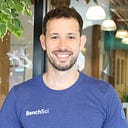The Power of Cadence for Building Your Startup Operating System
One of the challenges of being CEO of a growing startup is maintaining control without directly controlling everything. Once a company hits around 70 people, you must extract yourself from day-to-day operations, give your leadership team autonomy, and hold them accountable for goals.
But to do so, you need alignment, information flow, and accountability, with minimum overhead. How?
That’s where your company operating system comes in. It’s the machinery of planning, reporting, and accounting for activity. And the best way to build it is around a cadence framework.
How to achieve 10-year goals one day at a time
At BenchSci, we designed our company operating system around a cadence of 10-year, 5-year, quarterly, monthly, weekly, and daily activities. Here’s our approach:
10-year
- Mission review. Missions should be long-term. Once you find a product-market fit, you shouldn’t need to change your mission more than once a decade.
5-year
- BHAG review. Unlike your mission, your BHAG can change as your ambitions increase along with your achievements. So it’s good to review it more frequently than your mission.
Annual
- 2x-10x off-site. This is a yearly offsite meeting we hold with department heads. They create a presentation to answer two questions: How do we 2X results next year? How do we 10X them?
- Annual retro. Every December, we come together to celebrate the year and review all of our accomplishments and learning.
- Annual planning. Accounting for our annual retro and inspired by our 2X and 10X ideas, we set our yearly company goals, stream goals (technology, go-to-market, and operations), and budget.
- Annual kickoff. Every January, we kick off the year and present to the company our yearly goals and targets.
Quarterly
- Quarterly board update. This is a package of information to keep our board informed of progress and key developments. We build it with the involvement of the company’s senior management.
- Quarterly board meeting. After providing our board with an update package, we meet for discussion. The result is a more effective use of time, focusing on more strategic matters rather than communicating information that’s better shared asynchronously.
- Quarterly OKR planning. We begin this process about six weeks before the end of each quarter for the next quarter. It primarily involves department heads and senior managers.
- Quarterly retro and kickoff. At the end of each quarter, we regroup with the company to share progress on the quarter’s OKRs, and plans for the next quarter.
Monthly
- Monthly investor and company update report. As well as our quarterly board report, we send a 15-minute read to investors and the company each month to summarize the prior month. I record a Loom video as well.
- Monthly board huddle. The board meets for one hour each month to ensure alignment and address any issues that arise between quarterly board meetings.
- Stream-specific monthly review. We meet the senior management team of each stream (technology, go-to-market, and operations) to discuss the monthly update and ensure we’re progressing towards our yearly goals.
- Monthly product roadmap review. In this meeting, we review our product roadmap to ensure alignment amongst senior leadership.
- Monthly all-hands. Here we summarize our progress from the previous month and answer any questions.
- Monthly show and tell. We love learning from each other at BenchSci. At this meeting, different teams talk about their work in short PechaKucha-style presentations.
- Monthly town hall. This is an AMA session with the entire company. I take anonymous questions and answer them transparently.
Biweekly
- Biweekly department heads sync-up. Every two weeks, I meet with my entire team to address anything pressing we need to discuss.
- Stream-specific department head alignment with the CEO. Similar to the department heads sync-up, this meeting addresses anything pressing. The difference is that it’s focused only on one specific stream at a time.
- Managers AMA with the CEO. Every two weeks, I meet with all the people managers in the company to answer questions they might have. Anything goes.
Weekly
- Weekly OKR updates. At BenchSci, we use the OKR framework. We use Monday.com to track and update our OKRs. Each directly responsible individual updates their OKR progress every week.
- Weekly Lattice self-updates. In addition to reporting progress on OKRs, we also encourage people to report personal updates each week using Lattice. Each of my team members completes a seven-minute update answering the following questions: (1) What were your weekly accomplishments? (2) What did not work out well? (3) What do you plan to accomplish next week? (4) Which roadblocks can I remove? (5) What concerns you?
- Weekly stream-specific senior management meeting. As noted earlier, we think about the company in streams. These are technology (R&D, product and science, and engineering); go-to-market (marketing, sales, customer success, and program management); and operations (finance, people, and office of the CEO). The senior leadership of each stream (directors and up) meets every week to solve problems and ensure alignment.
- Weekly company newsletter. Every week we send a short company newsletter with the highs and lows of the previous week and what we’re aiming to accomplish in the current week. I also record a three-minute Loom video summarizing highlights.
Daily
- Daily stand-ups. Many of the teams at BenchSci, especially in engineering, have daily stand-ups. At these meetings, people typically discuss their accomplishments from the previous day, goals for the current day, and any help they may need.
While this might seem a lot, I have learned it is better to over-communicate than under-communicate to ensure we’re all working on the most critical projects to move us forward.
But, of course, we’re always working to optimize the process. Have any ideas for doing so? Please post them in the comments!
